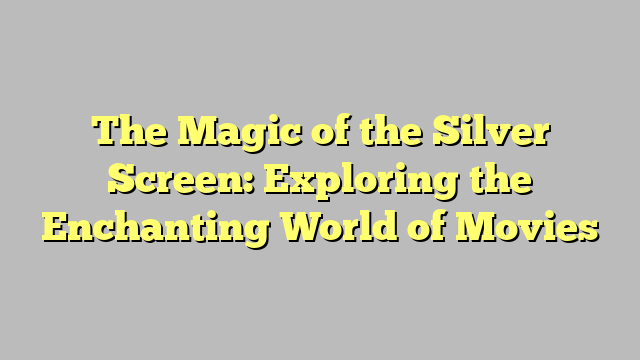
The Magic of the Silver Screen: Exploring the Enchanting World of Movies
Lights, camera, action! Movies have an indescribable power that can transport us to far-off worlds, evoke intense emotions, and ignite our imagination like no other medium can. For over a century, the silver screen has held a mesmerizing grip on audiences, captivating us with a combination of storytelling, visuals, and sound that create a truly enchanting experience. From the heartwarming tales that touch our souls to the pulse-pounding adventures that leave us on the edge of our seats, movies have a unique ability to bring together people from all walks of life to share in the magic of storytelling.
It is through movies that we can explore new horizons, experience different cultures, and gain a fresh perspective on life. Whether it’s stepping into the shoes of a courageous hero, delving into the depths of the human psyche, or simply being whisked away to a fantastical realm, movies allow us to escape from our own reality, even if only for a brief moment in time. They create a space where dreams can thrive, fears can be faced, and emotions can be unleashed. It is this escape, this chance to step outside of ourselves and see the world from a different angle, that makes movies such a powerful art form.
Evolution of Movies
The world of movies has undergone a captivating evolution over the years. From the early beginnings of silent films to the modern day blockbusters, the art of storytelling through motion pictures has truly come a long way.
In the early days of cinema, movies were a mesmerizing novelty. The first films were simple and experimental, often capturing everyday scenes or showcasing short stories. With time, however, filmmakers began to push the boundaries of creativity and technology, giving birth to a new era of cinematic possibilities.
One of the key milestones in the evolution of movies was the introduction of synchronized sound. This breakthrough in the late 1920s brought characters to life through dialogue and added a new dimension to storytelling. Audiences were spellbound as they could now not only see but also hear the emotions and conversations of their favorite on-screen characters.
As technology continued to advance, so did the visual effects in movies. The advent of color films in the 1930s opened up a whole new spectrum of possibilities for filmmakers to showcase vibrant worlds and capture the essence of their stories in a more immersive way. This shift from black and white to color truly revolutionized the cinematic experience.
From there, movies continued to evolve in leaps and bounds. Innovations such as computer-generated imagery (CGI) allowed filmmakers to create breathtaking and fantastical worlds that were once unimaginable. The boundaries of storytelling expanded as movies began to blend elements of reality with awe-inspiring visual effects, taking audiences on extraordinary journeys.
The evolution of movies has been a remarkable journey, from humble beginnings to the grand spectacles we witness on the silver screen today. As technology continues to advance, who knows what enchanting worlds and captivating stories await us in the future of cinema.
Impact of Movies on Society
https://www.fwiptv.tv/
Movies have always held a significant influence over society, shaping viewpoints, perceptions, and beliefs. Film as a medium has the power to leave a lasting impact on individuals and collective communities. Through their storytelling abilities, movies can provoke emotions, challenge societal norms, and provide a platform for important discussions.
Firstly, movies have the ability to evoke deep emotions within the viewers. Whether it’s joy, sadness, fear, or excitement, films have a way of transporting us into different worlds and eliciting powerful reactions. This emotional connection can create a sense of empathy and understanding among viewers, allowing them to relate to characters and situations they may not have otherwise encountered. Movies have the potential to bridge gaps between people and foster a sense of shared experience.
Secondly, films often reflect and critique the social and cultural aspects of the time in which they are produced. They can serve as a mirror to society, highlighting both the positive and negative aspects of our communal existence. By addressing important issues or shining a light on marginalized communities, movies have the ability to challenge stereotypes, raise awareness, and encourage dialogue about topics that require attention.
Lastly, movies can have a lasting impact on society by shaping popular culture and influencing trends. From fashion to music to language, films have the power to set trends and create cultural movements. They can introduce new ideas, perspectives, and concepts that resonate with audiences on both conscious and subconscious levels. Movies can inspire individuals, shaping their aspirations, dreams, and aspirations.
The influence of movies on society should not be underestimated. By evoking emotions, reflecting societal issues, and shaping popular culture, films have the power to leave a lasting impression on individuals and society as a whole. It is important to recognize and critically engage with the impact that movies have, and to continue exploring the enchanting world they offer.
The Future of Cinema
- Enhanced Visuals and Immersive Experiences
With advancements in technology, the future of cinema holds a promise of enhanced visuals and truly immersive experiences for moviegoers. As we continue to witness the progression from traditional film to digital, filmmakers are being empowered to explore new frontiers in visual storytelling. High-definition displays, crystal-clear audio, and sophisticated visual effects are just some of the elements that will transport audiences into breathtaking realms of imagination.
- Virtual Reality Integration
One fascinating aspect of the future of cinema is the integration of virtual reality (VR) technology. Imagine stepping into a movie and becoming an active participant in the narrative. Through VR headsets, viewers will be able to seamlessly interact with the movie’s environment, characters, and even manipulate elements of the story. This level of immersion will undoubtedly revolutionize the way we engage with films, enabling us to become integral parts of the cinematic world.
- Interactive Storytelling and Personalized Experiences
The future of cinema will also witness the rise of interactive storytelling and personalized movie experiences. With advancements in data analysis and AI, filmmakers will be able to create movies that adapt and respond to individual viewers’ preferences. Imagine a movie that dynamically adjusts its plot, characters, and even the ending based on the unique choices and reactions of each viewer. This level of customization will ensure that every moviegoer enjoys a tailor-made experience, making cinema even more engaging and captivating.
Please let me know if there is anything else I can assist you with.



